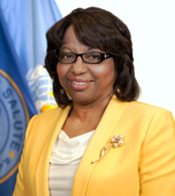
From moving quickly to train heads of state in risk communications, to making major decisions based on limited evidence, to sitting with Zika victims whose children had just been diagnosed with microcephaly, the head of the Pan American Health Organization (PAHO) offered a detailed assessment Sunday night of her experience with the sudden explosion of the Zika virus in the Americas.
In her keynote address to a packed hall at opening of ASTMH 2016 Annual Meeting, PAHO Director Dr. Carissa F. Etienne, MBBS, MSc, described the extraordinary experience and lessons learned from encounters with a once-obscure disease that now has been documented in 48 countries and territories in the Americas—and 67 globally.
Dr. Etienne credited “vigilant, astute, front-line health care workers” with first noting the unusual clusters of rash disease in Brazil in late 2014 that turned out to be an early indication that Zika virus had arrived. She noted it was also front-line health workers who first noted the spike in cases of microcephaly and Guillain-Barré Syndrome and connected them to the Zika virus.
Dr. Etienne said their “astute” observations have re-enforced her conviction that, when it comes to protecting the public from infectious disease, there is no substitute for “good clinical judgment and alertness for atypical events.”
Dr. Etienne recalled how quickly the situation escalated and the challenges this presented on a day-to-day basis. For example, heads of state wanted to take charge of discussing the emergency in radio and television appearances. So PAHO moved quickly to provide technical information along with training in risk communications.
There was also the fact that Zika was first discovered while many countries in the Americas were in the middle of preparing for potential Ebola infections and responding to outbreaks of chikungunya. Yet despite this confusing swirl of activity, she said health officials had to move swiftly to declare Zika an emergency, even though they lacked a complete picture of the true extent of the threat.
“Determination of causality needs to run its course, but PAHO cannot wait until the final verdict of the scientific community,” Dr. Etienne said. “We must be willing to make decisions based on incomplete evidence.”
Dr. Etienne said her experience with the Zika response has reminded her of the many ways infectious diseases take their toll on people, communities and countries. She said Zika has been particularly hard on countries in the Americas that already were suffering economically. And she said it was profoundly moving to spend time with parents whose children have been diagnosed with microcephaly linked to Zika.
“It was quite emotional,” she said. “Here are mothers and fathers loving their child and caring for their child but recognizing that this child’s life will probably be marked by disability.”
Dr. Etienne said that given limitations with diagnostic tests and disease surveillance, the current case count probably underestimates the true magnitude of Zika infections in the Americas. She also believes that “microcephaly is merely the tip of the iceberg” and it will take years to assess the full impact of Zika on children whose mothers were infected with Zika during pregnancy.
Among other things, Dr. Etienne said the experience with the Zika outbreak should prompt a re-thinking “of our approach to reproductive health services.”
“There is still a long way to go with Zika,” she said. “This is not going to be a 100 meter dash. This is a marathon in which science and public health must work hand in hand.”